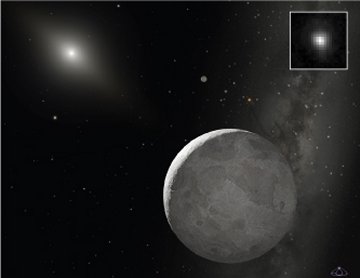Brilliant! Tenth planet turns out to be a shiner
Xena, unofficially called the 10th planet, is the second-most-shiny known object in the solar system, new observations show. Scientists are scrambling to explain where Xena got its sparkle. Some suggest that it might have enough heat to belch methane, despite being in the coldest region of the solar system.

The new notion of Xena arises from Hubble Space Telescope images that were released this week. The images reveal that Xena, the most distant known object in our solar system, isn’t quite the big shot that scientists had thought it was.
The chilly outpost’s diameter—2,384 kilometers—makes it about 5 percent larger than Pluto, Mike Brown of the California Institute of Technology in Pasadena and his colleagues announced April 11. That’s still large enough for Xena to retain its unofficial status as a planet, Brown says, but considerably smaller than ground-based observations had indicated (SN: 8/6/05, p. 83: Bigger than Pluto: Tenth planet or icy leftover?).
Researchers have difficulty determining the size of remote denizens of the solar system because a large object that reflects a small amount of sunlight looks the same as a small object reflecting a lot of light.
But for Xena, the sharp Hubble pictures erase that ambiguity.
The relatively small size shown in those images indicates that the body reflects 86 percent of sunlight. Brown says he was “thoroughly shocked” by that finding. Researchers had assumed that Xena’s surface was similar to that of Pluto, which reflects 60 percent of sunlight. Saturn’s moon Enceladus, recently shown to be shooting out a geyser of water vapor (SN: 1/7/06, p. 13: Available to subscribers at Moon spray), is the only solar system object known to have a higher reflectivity, notes Brown.
Scientists have proposed two scenarios to explain Xena’s high reflectivity. In one, a jet of methane leaks continuously from Xena. The methane jet freezes as it emerges, continually blanketing the surface with fresh snow.
What’s the heat source that could drive such activity? “Beats me,” says planetary scientist Rick Binzel of the Massachusetts Institute of Technology. He notes that gravitational tugs from a neighboring moon sometimes generate heat within a body, but Xena’s moon is too small to do that.
Another source of heat, sunlight, would penetrate only a few tens of meters below Xena’s surface and would probably have long ago depleted the reserves of methane there.
In the other model, the planet has a methane-rich atmosphere created during the portion of its 560-year-long orbit when it’s nearest the sun. As Xena speeds away, the atmosphere freezes on the surface as a bright frost. However, Brown says, it’s not clear that such frost would be bright enough to account for the shininess of Xena’s surface.







